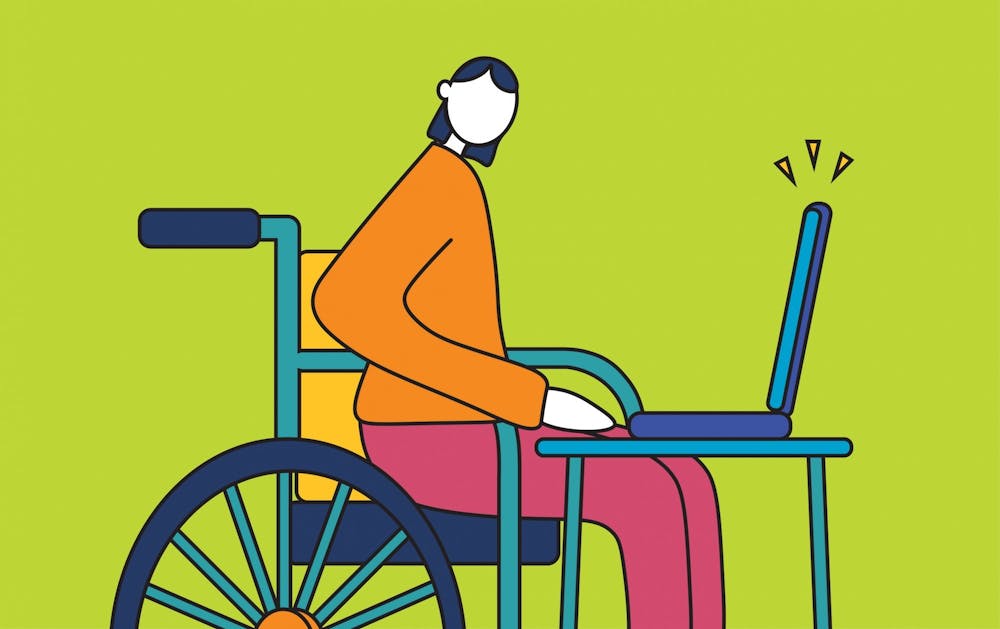If you’ve ever had a job on campus, you are likely aware of the many trainings that employees are required to take. One of these trainings is called "Diversity, Equity, and Inclusion." This training does an excellent job of covering certain minority groups that are discriminated against on the basis of sex, gender identity, race, and sexual orientation. The area I hope to see it expand on, however, is disability.
“A lot of people know what racist or sexist means, but if I say ableist they don’t know what that means,” said Krista Puruhito, a lecturer at the Sanford School.
I personally took this training for a job that I had before my position at The State Press. I went into the training feeling somewhat intrigued, but as someone with a disability who faces ableism, I left feeling irritated and unheard.
I remember perking up at the sight of the words "inclusive language," only to be disappointed when I hit the “next” arrow and was confronted with "person-first language."
Person-first vs identity-first language has been a popular debate in the disability community. It began in the early 2000s when several people with disabilities who advocate against ableism, a term still unknown to many, identified themselves as "self-advocates."
Ableism is discrimination against those who have a disability. At first, the disability community decided using person-first language was the correct way of identifying someone with a disability. The idea is to say "person with a disability," instead of "disabled person."
One point raised by Elizabeth Swadener, a professor at ASU's School of Social Transformation, was the fact that ableism can be intersectional with other marginalized groups, and those who are a double-minority will face even more roadblocks.
As explained in the training, an individual is a person first. They are not defined by their disability. They are more than their disability. This ideology, however, has shifted in recent years.
Nowadays, some activists prefer using "identity-first language." The Blind, Deaf, and Autistic communities, for example, prefer speaking in this way. The argument in using identity-first language is that our disabilities do define us, and that isn’t a bad thing.
For example, I am a person with autism. If I did not have autism, I would argue that my life and personality would be very different. Autism, along with other conditions, has positive and negative traits, but it does alter the way that a person experiences life.
I believe that, while well-intentioned, person-first language tries to distance the individual from their disability because society sees disability as a bad thing. It is a taboo subject because people are uncomfortable with the fact that disabled people cannot do certain things.
Another argument the disability community likes to bring up is the fact that you would not call somebody a "person with Black" or "a person with gay." You would call them a "Black person," or a "gay person." Black and gay are not bad traits and neither is disabled.
While I may use person-first language in my columns, as that is what I am dictated to use by the AP Style Guide, in my everyday life I identify as a disabled person or autistic person. Yes, my autism does cause me to have a hard time in certain situations, but I would not be the person I am if I were neurotypical.
I truly hope the creators of this training can consider the feelings of myself and the disability community at large. I personally believe the best way to refer to an individual with a disability is by using the language they prefer to be identified with, whether it be person-first or identity-first.
We also need to include disability in the ongoing conversation about discrimination and the other -ism’s we see. Do not include disability solely on one page of your entire training, especially if you plan to do it in a way that many of us do not see ourselves represented in.
Puruhito agrees that it should be up to the individual how they identify.
Anyone who is facing workplace discrimination should reach out to someone they feel comfortable talking to, Puruhito said. "Things will not change unless people know it is an issue," she said.
My hope is that the Office of Diversity, Equity, and Inclusion can speak to individuals from the disability community, revise their training and do better.
Reach the columnist at htenore@asu.edu or follow @haleyyhmt on Twitter.
Editor’s note: The opinions presented in this column are the author’s and do not imply any endorsement from The State Press or its editors.
Want to join the conversation? Send an email to opiniondesk.statepress@gmail.com. Keep letters under 500 words and be sure to include your university affiliation. Anonymity will not be granted.
Like The State Press on Facebook and follow @statepress on Twitter.
Continue supporting student journalism and donate to The State Press today.

Haley Tenore is the editor of the State Press Opinion Desk. Tenore is also a digital reporter for Cronkite News and a co-president of the Accessibility Coalition. This is her fourth semester on the opinion desk and second semester as editor.




